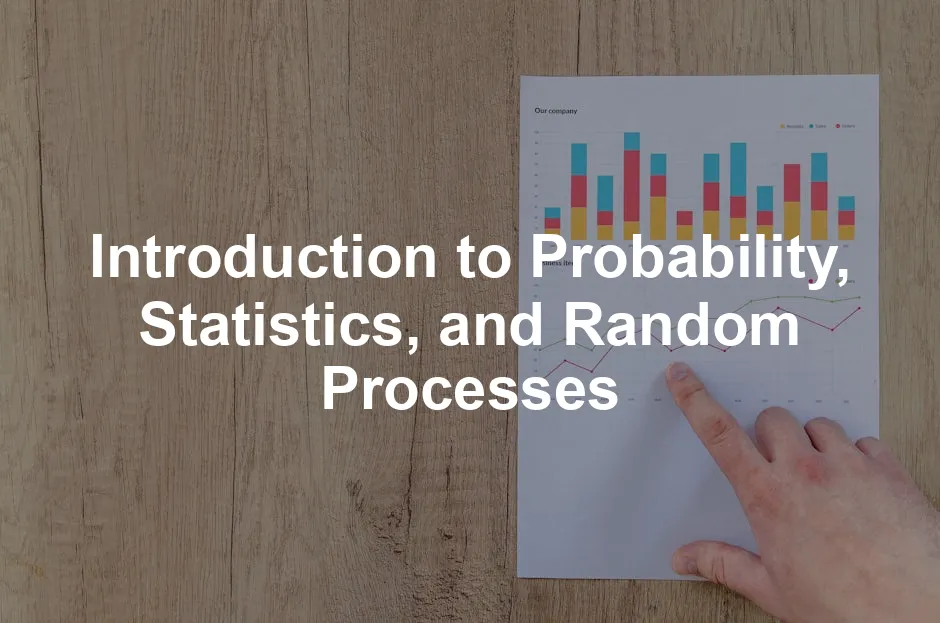Introduction
Probability, statistics, and random processes are crucial in our data-driven world. They help us make sense of uncertainty and randomness. From engineering marvels to financial forecasts, these concepts are woven into the fabric of various fields. Imagine trying to engineer a bridge without understanding the likelihood of load stresses or predicting stock market trends without statistical analysis. It’s a bit like baking a cake without measuring ingredients—chaotic! The objective of this article is to demystify these topics. We aim to provide a comprehensive introduction that caters to beginners. Practitioners will find valuable insights, too. Whether you’re a student, professional, or just curious, this piece is for you. We will cover foundational concepts of probability, including its definition and significance. You’ll learn about random experiments, sample spaces, and events. The article will also introduce core principles like Kolmogorov’s axioms and the importance of conditional probability. Each section is designed to build upon the previous one, guiding you through the intricate landscape of probability and statistics. Get ready for a fun ride filled with enlightening examples and practical applications. By the end, you’ll not only grasp these concepts but also appreciate their pervasive role in our everyday lives. So, let’s roll up our sleeves and jump right into the wonderful world of probability, statistics, and random processes!While you’re diving into the world of probability, why not enhance your reading experience with a Statistical Learning with Python? It’s like having a personal tutor guiding you through the complexities of data analysis.For a deeper understanding of statistical concepts, check out this comprehensive guide on an introduction to statistical learning with python book length.

Understanding Probability
Definition of Probability
Probability is all about quantifying uncertainty. It helps us understand random events and outcomes. Think of it as the numerical way of saying, “There’s a chance this could happen.” It’s the backbone for making informed decisions in uncertain situations. At its core, probability begins with random experiments. A random experiment is an action or process whose outcome is uncertain. For instance, flipping a coin is a simple random experiment. Each flip can result in either heads or tails, but you can’t predict the outcome. Next, we have the sample space. This is the set of all possible outcomes for a random experiment. For our coin flip, the sample space is {heads, tails}. An event is a specific outcome or a collection of outcomes from the sample space. So, an event could be getting heads when you flip the coin. Understanding these foundational concepts is crucial. They set the stage for more advanced ideas in probability, allowing us to navigate through the sea of uncertainty with confidence.Probability Axioms
Enter Kolmogorov’s axioms of probability. These are the fundamental rules that govern how we calculate probabilities. The first axiom states that the probability of any event is a non-negative number. Simply put, you can’t have a negative chance of anything happening—sorry, bad luck! The second axiom tells us that the total probability of all outcomes in a sample space is one. So, if you consider all possibilities, something must happen. Lastly, the third axiom covers mutually exclusive events. If two events cannot happen at the same time, their probabilities add up. For example, if you roll a die, the event of rolling a 1 and rolling a 2 are mutually exclusive. The probability of rolling a 1 or a 2 is the sum of their individual probabilities. If you’re interested in diving deeper into probability, consider picking up a classic book on Probability Theory. It’s an excellent resource for anyone looking to solidify their understanding of these essential concepts.
Conditional Probability and Independence
Conditional probability is a fascinating concept. It measures the likelihood of an event occurring, given that another event has already occurred. Picture this: You have a bag of marbles, some red and some blue. If you know a marble drawn is red, the probability of drawing a blue marble next changes. That’s conditional probability in action! Independence is another key idea. Two events are independent if the occurrence of one does not affect the other. For example, flipping a coin and rolling a die are independent events. The outcome of one has no bearing on the other. Understanding these concepts helps us make better predictions and decisions based on available information. Now you’re equipped with the essential building blocks of probability. Each concept plays a significant role in how we analyze data and make informed choices in uncertain situations. Let’s continue our journey through the exciting world of statistics and random processes!Counting Methods
Counting methods are fundamental tools in probability. They help us determine the number of ways to arrange or select items. In the realm of probability, understanding these techniques is crucial. Let’s break down the two primary methods: permutations and combinations.Permutations
Permutations account for arrangements. When the order of items matters, permutations come into play. For instance, think of arranging books on a shelf. If you have three different books, say A, B, and C, the possible arrangements are ABC, ACB, BAC, BCA, CAB, and CBA. That’s six unique ways! The formula for permutations is given by: \[ P(n, r) = \frac{n!}{(n – r)!} \] Here, \( n \) is the total items, and \( r \) is the number of items to arrange. The factorial (n!) represents the product of all positive integers up to \( n \). So, if you need to arrange 4 books from a total of 6, you would compute \( P(6, 4) = \frac{6!}{(6 – 4)!} \), resulting in 360 unique arrangements.
Combinations
Now, let’s talk combinations. This method is used when the order doesn’t matter. Imagine you’re picking toppings for a pizza. If you can choose any three from a list of five, the order in which you select them doesn’t affect your choice. The formula for combinations is: \[ C(n, r) = \frac{n!}{r!(n – r)!} \] Again, \( n \) represents the total items, while \( r \) is how many you choose. Using our pizza example, if you have 5 toppings and want to choose 3, you would compute \( C(5, 3) = \frac{5!}{3! \times 2!} \), yielding 10 different topping combinations.Applications in Probability
Understanding permutations and combinations is essential in probability. They help calculate probabilities of complex events. For instance, consider a lottery scenario. If you need to pick 6 numbers out of 49, you’d use combinations to find the total number of ways to choose those numbers. Specifically, you’d compute \( C(49, 6) \). In essence, these counting methods form the backbone of probability calculations. They enable us to quantify the likelihood of different outcomes. Whether you’re organizing a game night or analyzing data, mastering these techniques is invaluable. With this knowledge, you can tackle more complex statistical problems with confidence.
Expectation and Variance
Expectation and variance are two fundamental concepts in statistics. They help us understand random variables better. Expectation, often denoted as E(X), represents the average or mean value of a random variable. It gives us insight into what we can expect if we were to repeat an experiment many times. For example, if you roll a fair six-sided die, the expected value is calculated as follows: \[ E(X) = \frac{1}{6}(1 + 2 + 3 + 4 + 5 + 6) = \frac{21}{6} = 3.5 \] This means that while you can’t roll a 3.5, over many rolls, the average will trend toward this number. Variance, on the other hand, measures the spread of a random variable around its mean. It helps us understand how much variability there is in our data. The variance of a random variable X is denoted as Var(X) and is calculated as: \[ Var(X) = E[(X – \mu)^2] \] where μ is the expectation. For the six-sided die example, we first find the variance: 1. Calculate the expectation (mean), which is 3.5. 2. Find the squared differences from the mean: \[ (1 – 3.5)^2 = 6.25, \quad (2 – 3.5)^2 = 2.25, \quad (3 – 3.5)^2 = 0.25, \] \[ (4 – 3.5)^2 = 0.25, \quad (5 – 3.5)^2 = 2.25, \quad (6 – 3.5)^2 = 6.25 \] 3. Compute the average of these squared differences: \[ Var(X) = \frac{1}{6}(6.25 + 2.25 + 0.25 + 0.25 + 2.25 + 6.25) = \frac{17.5}{6} \approx 2.92 \] So, the variance for our die is approximately 2.92. By knowing both expectation and variance, we gain valuable insights into the behavior of random variables. It tells us not just what we can expect, but also how much variability exists in that expectation. If you’re curious about applying these concepts practically, consider investing in a Statistics for Data Science book. It provides practical applications that can help you solidify your understanding of these important concepts.
Limit Theorems and Convergence
Law of Large Numbers
The Law of Large Numbers (LLN) is a fundamental theorem in probability. It states that as the number of trials increases, the sample average will converge to the expected value. In simpler terms, the more times we perform an experiment, the closer the average result will be to what we expect. Imagine flipping a coin. If you flip it just a few times, you might get heads three times and tails once. But if you flip it 1,000 times, you’ll find the ratio of heads to tails approaches 0.5. That’s the magic of the LLN at work! Consider a practical example: Suppose you’re a pizza shop owner. You want to know the average number of pizzas sold on Fridays. If you only observe one Friday, you might see a spike in sales. But if you track sales for a year, you’ll get a much clearer picture of your average sales. This theorem is crucial for making predictions based on sample data. It reassures us that with enough data, we can expect reliable averages that reflect the true nature of the process being studied.Central Limit Theorem
The Central Limit Theorem (CLT) is another cornerstone of statistics. It explains that when you take a large enough sample from any population, the distribution of the sample means will be approximately normally distributed, regardless of the population’s distribution. Why is this important? Because it allows us to make inferences about population parameters even when we don’t know the underlying distribution. For example, let’s say you’re measuring the height of adult males in a city. The actual distribution might be skewed. But if you take a sample of 30 men and calculate their average height, that average will follow a normal distribution. This holds true as long as the sample size is sufficiently large. The applications of the CLT are vast. It enables statisticians to conduct hypothesis testing and create confidence intervals. For instance, in quality control, manufacturers use the CLT to ensure products meet specifications by sampling and analyzing their characteristics.In summary, both the Law of Large Numbers and the Central Limit Theorem provide essential tools for understanding probabilities and making statistical inferences. They show us that with enough data, we can paint a clearer picture of reality. If you want to dig deeper into statistical methodologies, consider checking out a Statistics for Business and Economics book. It covers practical applications that can help you understand the relevance of these theorems in real-world scenarios.To explore the importance of the Central Limit Theorem in statistics, visit the central limit theorem is important in statistics because.

Introduction to Random Processes
What are Random Processes?
Random processes, also known as stochastic processes, are mathematical models that describe systems evolving over time in a probabilistic manner. They are integral to numerous fields, including engineering, finance, and telecommunications. Random processes help us understand phenomena where uncertainty is inherent. Let’s clarify the types: Discrete-time processes are defined at specific intervals. Imagine flipping a coin every second. You can record the outcome at each second, creating a sequence of results. Each flip represents a point in time. On the other hand, continuous-time processes are defined at every moment. Think of a stock price that fluctuates continuously throughout the trading day. Here, you can observe the price at any infinitesimal point in time. The relevance of random processes is profound. In telecommunications, they model signal transmission and noise. In finance, they help in option pricing and risk assessment. Understanding these processes allows professionals to make informed decisions based on predictions of future behavior. In summary, random processes are vital for modeling and analyzing systems subject to uncertainty. By grasping the distinctions between discrete and continuous processes, you can better navigate the unpredictable nature of various fields.Key Concepts in Random Processes
Understanding random processes is essential for various fields, from engineering to finance. These processes help us model real-world systems affected by uncertainty. Let’s break down some key concepts.Markov Chains
Markov chains represent a type of random process where the future state depends only on the current state. This property is called “memorylessness.” Imagine playing a board game. Your next move depends solely on where you are, not on how you got there. Key Properties: – State Space: The set of all possible states. – Transition Probabilities: The likelihood of moving from one state to another. For example, consider weather forecasting. If today is sunny, the probability of tomorrow being sunny might be high, while the chance of rain might be low. Markov chains are widely used in fields like queueing theory, stock market analysis, and even Google’s PageRank algorithm!Poisson Processes
A Poisson process is a model for counting the number of events happening in a fixed interval of time or space. The events occur independently and at a constant average rate. Think of it as waiting for a bus: on average, one bus arrives every ten minutes, but the exact timing is random. Significance: – Memoryless Property: The time until the next event follows an exponential distribution. – Applications: Poisson processes are used in telecommunications to model call arrivals and in queueing theory to analyze customer service systems. For instance, if a customer service center receives an average of five calls per hour, a Poisson process can help predict the likelihood of receiving a certain number of calls in any given hour.Brownian Motion
Brownian motion describes the random movement of particles suspended in a fluid. This concept has significant implications in both finance and physics. In finance, it models stock prices, assuming they move in a continuous, random fashion over time. Applications: – Finance: Used in option pricing models like the Black-Scholes model. – Physics: Helps explain diffusion processes. Essentially, Brownian motion captures the idea that small, random movements can lead to significant changes over time. It’s a cornerstone of stochastic calculus and essential for understanding complex systems. In summary, grasping these key concepts—Markov chains, Poisson processes, and Brownian motion—equips you with the tools to analyze and predict behaviors in uncertain environments. These concepts bridge theoretical knowledge and practical applications, making them invaluable across various disciplines.To learn more about statistical mechanics simulations, check out statistical mechanics simulations.
Examples of Simulation
Simulations are fascinating tools that help us understand complex systems across various fields. Let’s take a look at some examples in finance and engineering. In finance, simulations are like crystal balls. They allow analysts to model market behaviors and investment strategies. For instance, Monte Carlo simulations estimate the potential returns on investment portfolios. By generating thousands of random market scenarios, they provide insights into risk and return. Investors can visualize how their investments might perform under different economic conditions. It’s almost like having a financial fortune teller, minus the crystal ball! Now, let’s switch gears to engineering. Simulations play a crucial role in designing structures and systems. Engineers often use finite element analysis (FEA) to predict how structures respond to forces. For example, before building a bridge, engineers simulate how it would react to wind, weight, and stress. This helps them design safer and more efficient structures. It’s like a dress rehearsal before the big show! In healthcare, simulations are used for training and testing new treatments. Medical professionals can practice surgical procedures in a risk-free environment. These simulations provide realistic scenarios, allowing doctors to hone their skills without endangering patients. It’s a lifesaver in training! Simulations can also aid in decision-making. They allow businesses to test various strategies before implementing them. By modeling potential outcomes, companies can identify risks and opportunities. For instance, a manufacturing company might simulate changes in production processes to improve efficiency. This proactive approach minimizes costly mistakes. If you’re interested in enhancing your simulation capabilities, you might consider picking up a book on Simulation Modeling and Analysis. This book covers essential techniques that can help you master the art of simulation.
FAQs
What is the difference between probability and statistics?
Probability and statistics are closely related but distinct fields. Probability focuses on predicting the likelihood of future events based on known information. In contrast, statistics involves analyzing past data to draw conclusions or make inferences about a population. Simply put, probability is about what could happen, while statistics is about what has happened.
How are random processes used in real life?
Random processes find applications in various industries. In finance, they model stock price movements, helping analysts assess risks. In telecommunications, random processes are used to analyze call arrivals and network traffic. In healthcare, they assist in understanding patient flow in hospitals, optimizing resource allocation. These applications demonstrate the versatility and importance of random processes in solving real-world problems.
What are some good resources for learning more about these topics?
If you’re eager to expand your knowledge, there are excellent resources available. A highly recommended textbook is “Introduction to Probability, Statistics, and Random Processes” by Hossein Pishro-Nik. It covers fundamental concepts and includes practical examples. Additionally, consider online courses on platforms like Coursera or edX, which offer interactive learning experiences. Websites like Khan Academy and ProbabilityCourse.com also provide valuable materials for self-study.
Can you explain the significance of the Central Limit Theorem?
The Central Limit Theorem (CLT) is a cornerstone of statistics. It states that the distribution of sample means approaches a normal distribution as the sample size increases, regardless of the original population’s distribution. This is significant because it allows statisticians to make inferences about population parameters using sample data. The CLT is fundamental for hypothesis testing, confidence intervals, and many other statistical applications, enabling us to draw reliable conclusions from limited data.
All images from Pexels




